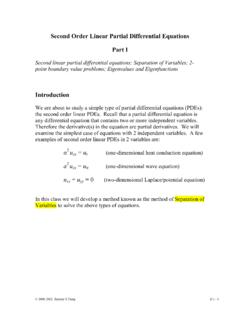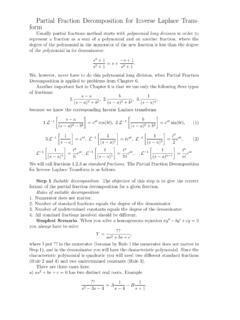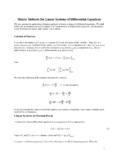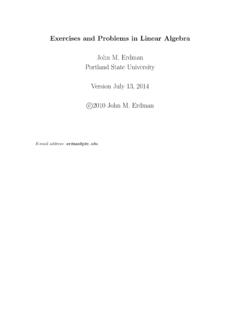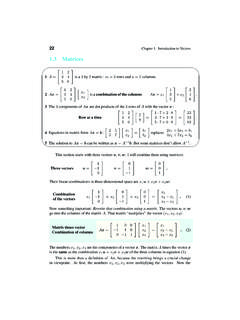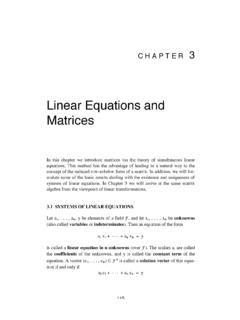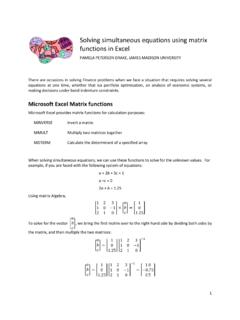Transcription of Systems of First Order Linear Differential Equations
1 2008, 2012 Zachary S Tseng D 1 1 Systems of First Order Linear Differential Equations We will now turn our attention to solving Systems of simultaneous homogeneous First Order Linear Differential Equations . The solutions of such Systems require much Linear algebra (Math 220). But since it is not a prerequisite for this course, we have to limit ourselves to the simplest instances: those Systems of two Equations and two unknowns only. But First , we shall have a brief overview and learn some notations and terminology. A system of n Linear First Order Differential Equations in n unknowns (an n n system of Linear Equations ) has the general form: x1 = a11 x1 + a12 x2 +.
2 + a1n xn + g1 x2 = a21 x1 + a22 x2 + .. + a2n xn + g2 x3 = a31 x1 + a32 x2 + .. + a3n xn + g3 (*) : : : : : : xn = an1 x1 + an2 x2 + .. + ann xn + gn Where the coefficients aij s, and gi s are arbitrary functions of t. If every term gi is constant zero, then the system is said to be homogeneous. Otherwise, it is a nonhomogeneous system if even one of the g s is nonzero. 2008, 2012 Zachary S Tseng D 1 2 The system (*) is most often given in a shorthand format as a matrix vector equation, in the form: x = Ax + g + = nnnnnnnnnnggggxxxxaaaaaaaaaaaaxxxx::::.. ::::::::..::32132121332312222111211321 x A x g Where the matrix of coefficients, A, is called the coefficient matrix of the system.
3 The vectors x , x, and g are x = nxxxx:321, x = nxxxx:321, g = ngggg:321. For a homogeneous system, g is the zero vector. Hence it has the form x = Ax. 2008, 2012 Zachary S Tseng D 1 3 Fact: Every n th Order Linear equation is equivalent to a system of n First Order Linear Equations . (This relation is not one to one. There are multiple Systems thus associated with each Linear equation, for n > 1.) Examples: (i) The mechanical vibration equation m u + u + k u = F(t) is equivalent to mtFxmxmkxxx)(21221+ = = Note that the system would be homogeneous (respectively, nonhomogeneous) if the original equation is homogeneous (respectively, nonhomogeneous).
4 (ii) y 2y + 3y 4y = 0 is equivalent to x1 = x2 x2 = x3 x3 = 4 x1 3 x2 + 2 x3 2008, 2012 Zachary S Tseng D 1 4 This process can be easily generalized. Given an n th Order Linear equation any(n) + an 1 y(n 1) + an 2 y(n 2) + .. + a2 y + a1 y + a0 y = g(t). Make the substitutions: x1 = y, x2 = y , x3 = y , .. , xn = y(n 1), and xn = y(n). The First n 1 Equations follow thusly. Lastly, substitute the x s into the original equation to rewrite it into the n th equation and obtain the system of the form: x1 = x2 x2 = x3 x3 = x4 : : : : : : xn 1 = xn nnnnnnnnatgxaaxaaxaaxaax)(.
5 1322110+ = Note: The reverse is also true (mostly)*. Given an n n system of Linear Equations , it can be rewritten into a single n th Order Linear equation. * The exceptions being the Systems whose coefficient matrices are diagonal matrices . However, our Eigenvector method will nevertheless be able to solve them without any modification. 2008, 2012 Zachary S Tseng D 1 5 Exercises D : 1 3 Convert each Linear equation into a system of First Order Equations . 1. y 4y + 5y = 0 2. y 5y + 9y = t cos 2t 3. y(4) + 3y y + 2 y 6y = 11 4.
6 Rewrite the system you found in (a) Exercise 1, and (b) Exercise 2, into a matrix vector equation. 5. Convert the third Order Linear equation below into a system of 3 First Order equation using (a) the usual substitutions, and (b) substitutions in the reverse Order : x1 = y , x2 = y , x3 = y. Deduce the fact that there are multiple ways to rewrite each n th Order Linear equation into a Linear system of n Equations . y + 6y + y 2y = 0 Answers D : 1. x1 = x2 2. x1 = x2 x2 = 5x1 + 4x2 x2 = x3 x3 = 9x1 + 5x3 + t cos 2t 3. x1 = x2 x2 = x3 x3 = x4 x4 = 6x1 2 x2 + x3 3x4 + 11 4.
7 (a) x = 4510x (b) x = 509100010x + tt2cos00 5. (a) x1 = x2 (b) x1 = 6x1 x2 + 2x3 x2 = x3 x2 = x1 x3 = 2x1 x2 6x3 x3 = x2 2008, 2012 Zachary S Tseng D 1 6 A Crash Course in (2 2) matrices Several weeks worth of matrix algebra in an (Relax, we will only study the simplest case, that of 2 2 matrices .) Review topics: 1. What is a matrix (pl. matrices )? A matrix is a rectangular array of objects (called entries). Those entries are usually numbers, but they can also include functions, vectors, or even other matrices .
8 Each entry s position is addressed by the row and column (in that Order ) where it is located. For example, a52 represents the entry positioned at the 5th row and the 2nd column of the matrix A. 2. The size of a matrix The size of a matrix is specified by 2 numbers [number of rows] [number of columns]. Therefore, an m n matrix is a matrix that contains m rows and n columns. A matrix that has equal number of rows and columns is called a square matrix. A square matrix of size n n is usually referred to simply as a square matrix of size (or Order ) n. Notice that if the number of rows or columns is 1, the result (respectively, a 1 n, or an m 1 matrix) is just a vector.
9 A 1 n matrix is called a row vector, and an m 1 matrix is called a column vector. Therefore, vectors are really just special types of matrices . Hence, you will probably notice the similarities between many of the matrix operations defined below and vector operations that you might be familiar with. 2008, 2012 Zachary S Tseng D 1 7 3. Two special types of matrices Identity matrices (square matrices only) The n n identity matrix is often denoted by In. I2 = 1001, I3 = 100010001, etc. Properties (assume A and I are of the same size): AI = IA = A In x = x, x = any n 1 vector Zero matrices matrices that contain all zero entries.
10 Properties: A + 0 = 0 + A = A A 0 = 0 = 0 A 4. Arithmetic operations of matrices (i) Addition / subtraction = hdgcfbeahgfedcba 2008, 2012 Zachary S Tseng D 1 8 (ii) Scalar Multiplication = kdkckbkadcbak, for any scalar k. (iii) Matrix multiplication ++++= dhcfdgcebhafbgaehgfedcba The matrix multiplication AB = C is defined only if there are as many rows in B as there are columns in A. For example, when A is m k and B is k n. The product matrix C is going to be of size m n, and whose ij th entry, cij, is equal to the vector dot product between the i th row of A and the j th column of B.




